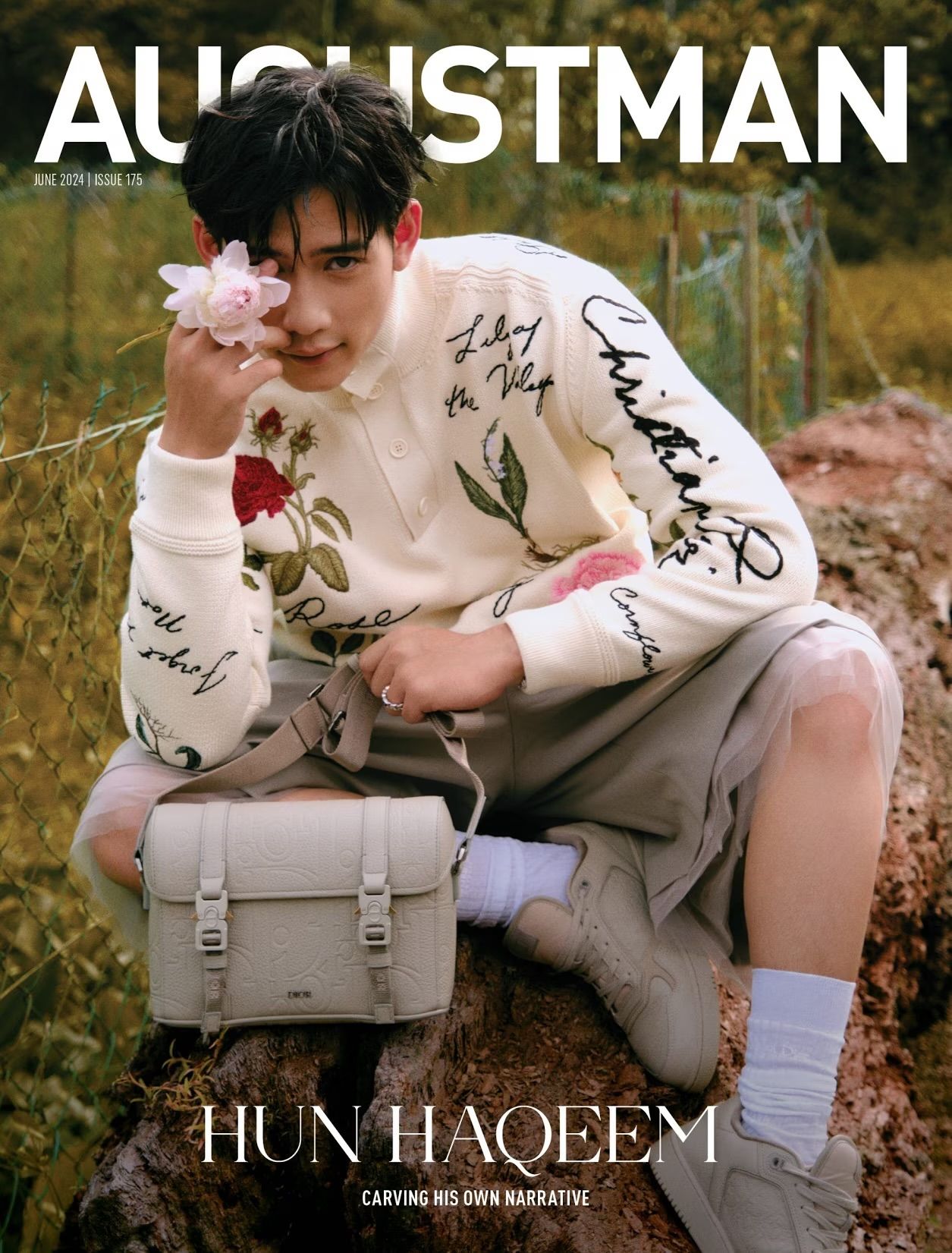
Journalling is a practice that dates back millennia, with some of the greatest minds in history such as Marcus Aurelius and Anaïs Nin having kept detailed accounts of their lives.
Sometimes, these personal accounts – like Anne Frank’s diary or Da Vinci’s notes – have educated generations way beyond their time, which showcases how influential journals can be beyond a personal exploration tool.
Mention the word ‘journal’ and the first image that comes to mind is one of the boring entries starting with ‘Dear diary’. But journalling is much more than that. It can be a powerful tool for self-growth, daily reflection, and creative inspiration.
Plus, it’s a great way to document your life for future generations – in other words, a way to embarrass yourself posthumously.
And as part of our analogue theme for this month, Augustman has invited Jane Lee, a journal artist, to share the many other ways that one can approach the craft. She regularly hosts workshops on all things journalling, and will be demystifying the process, hopefully to rope you into this wonderful practice.
A quick primer

Journalling means different things to everyone. And for Lee, it is a means of art, allowing her to express herself. What journalling means to me is an art form that allows me to express myself. “Taking pictures is also art,“ she says. “During my assignments as a wedding photographer, I’d take extra pictures for my own journal, captioning each of them to record those little moments along the way.
“So don’t think of it as something set in stone. A lot of people see my journals online and they’re scared to try because they can’t be like me. But this is a personal practice. Not a comparing game. If you prefer writing, do that. If you express yourself best through drawing, you can too. As long as you have a book and a pen, you’re good to go.”
Travel journalling
This is one of the main ways people get started with journalling. They go somewhere new, decide to record their once-in-a-lifetime memories, then end up continuing the practice when they get home.
For Lee, she keeps all the ephemera from her journey to remind her of the everyday moments during her trip, which will inevitably turn into happy memories a few more years down the line.
“I collect most things, like the skydiving brochure, beer bottle labels, even egg muffin packaging from the supermarket,“ she says. “I can’t draw, so this is my main way of recording my travels, besides photos.”
Lee recommends new journal keepers not to overthink it. “It’s very simple. Start with the most basic things you want to do. Then once you get used to it, you can start exploring new mediums.”


Trash journalling
Junk journaling is a creative practice that uses a combination of recycled materials and found objects to create unique journals. Unlike traditional journals with pages of neatly-written text, junk journals are filled with a mishmash of images, words, and objects that often involve discarded items.
“It can be hard when people start journalling,” Lee says. “Because they tend to collect everything, thinking they’ll use it for their journal. Anything can qualify as trash, after all. So my biggest recommendation is to filter what’s needed and what’s not needed.
“But differentiating between what’s needed and what’s not will only come through practice. Which is why this genre of journalling isn’t for everyone.”
Junk journaling is not only a fun and creative outlet, but it is also an eco-friendly way to repurpose materials that might otherwise end up in the trash. The downside is that, as Lee highlights, if you enjoy junk journalling regularly, you may find that the material will begin to take up a lot of space in your home.


Art journalling
“This is a very fun style of journalling to try,” Lee says. “Whatever you’re thinking, just do it.”
If someone who’s a self-professed non-artist can have fun with this style of journalling, then there’s no reason why anyone else can’t. It’s not so much a collection of perfection more than it is a visual way of recording your life.
It can function as therapy or as a way to explore your creativity, with many more tools at your disposal besides the usual pen or pencil – watercolour, crayons, washi tape, fine liners, and markers.
Another benefit of art journaling is that it allows you to document your personal growth and creativity over time. As you fill your journal with your artwork, you can look back and see how far you’ve come when it comes to visual expression.
For these particular spreads, Lee started out testing the inks and colours with doodles, which then expanded across the entire page. “If it doesn’t turn out right, it’s okay. You can always try again on a different page,” Lee says.


Planner
With the bullet journal taking over the world by storm, the planner almost fell to the wayside compared to its more efficient counterpart.
But some people still prefer the traditional planner, and for good reason. They only have one purpose, and they perform that purpose well – and that’s keeping you organised.
In addition to helping you stay organised, using a planner can also have mental health benefits. Writing down your tasks and goals can help reduce stress and anxiety, as it can help you feel more in control of your life. Plus, crossing items off your to-do list can be a satisfying way to track your progress and feel a sense of accomplishment.
Lee enjoys using monthly and weekly spreads, and she records both in advance as well as in retrospect. So her planners double up as organisers as well as a diary of events.
Just like the other forms of journalling, Lee recommends aspiring journal-keepers to record anything of meaning to them. So some people might find creative time unworthy of being a planner entry, while others might find it useful. “It’s all about using it to fit your lifestyle. It can be as basic or as detailed as you want.”


Gratitude journalling
Gratitude journaling is a practice that involves regularly writing down things for which you are grateful. It’s a simple yet powerful way to cultivate a positive outlook and increase feelings of happiness and well-being.
By focusing on the good things in our lives, we can train our brains to be more optimistic and appreciative, even during difficult times. Gratitude journaling can be done in a variety of ways, from writing a daily list of things you’re thankful for to reflecting on specific moments or experiences that brought you joy.
No matter how you choose to practice it, gratitude journaling can be a transformative practice that can help you live a more joyful and fulfilling life.
Lee has an interesting method of practising gratitude journalling. She collects prompts and writes them on Post-It notes. An example would be: “Name three things you like about your neighbourhood.” Then whenever she wants, she simply flips to the prompts page and pulls out a note by random.
She then spends the next few minutes to an hour answering the prompt, staying true to her favourite method of expression: photography.
“I recommend starting with this version of gratitude journalling because it’s the easiest,” Lee says. “You don’t even need to write anything fancy. Even answering with a few words is effective enough.”


Explore your narrative
There are so many other ways to keep a journal, and if there’s one takeaway you get from this, it’s that you should journal exactly how you want to. The moment it starts feeling like a chore is when the practice loses its magic. Because at the end of the day, journalling isn’t a destination. It’s a journey. And just like Lee says, it’s a journey that only involves a pen and a book.
Behind The Pages
The Augustman team shares their own ways of journalling and what it means to them.

Scrapbook
KC Yap, Editor
I started this scrapbook mostly because I couldn’t afford books back in secondary school. So I would trawl newspapers and magazines for interesting articles to cut and paste (literally) into the notebooks. I used it to learn new words and fancy turn of phrases, and that’s possibly why I’m in the publishing industry today.

Wall journal
Joyce Lim, Art Director
I’ve collected random ephemera even before I had this wall journal, and I enjoy staring at it when I get ready in the mornings. Each item sets off a chain of memories, and besides holding much sentimental value, they also inspire me to travel more, make new memories, and collect extra trinkets for the wall.

Freewriting journal
Stuart Danker, Deputy Editor
I work best with words, so I typically default to long-winded entries recounting how my day went. Some days I can go on for pages. On other days, it’s just a sentence. I enjoy free writing because I get to discover thoughts I never knew I had, and in turn, get to address them.





